How Drugs Affect the Brain
Understanding how drugs affect the brain is crucial for comprehending the mechanisms behind addiction and the associated behavioral changes. Drugs of abuse can profoundly impact the brain's neurotransmitter systems, leading to various effects on brain function and behavior.

The Role of Neurotransmitters
Neurotransmitters are chemical messengers in the brain that facilitate communication between neurons. They play a critical role in regulating various functions, including mood, reward, and motivation. Drugs of abuse can interfere with the normal functioning of neurotransmitters, leading to significant alterations in brain activity.
Among the neurotransmitters affected by drugs, dopamine holds great importance. Dopamine is involved in the brain's reward pathway, the nigrostriatal pathway, and the tuberoinfundibular pathway. Most drugs of abuse interfere with dopamine signaling, impacting all three of these pathways. This interference can result in an artificial increase in the release of dopamine, leading to intense feelings of pleasure and reinforcing drug-seeking behavior.
Impact on Dopamine Signaling
Drugs of abuse, such as cocaine, amphetamines, and opioids, can lead to an excessive release of dopamine in the brain. This surge in dopamine levels can reinforce drug consumption, leading to addictive behaviors that prioritize drug-seeking over healthier activities. The repeated activation of the brain's reward circuitry by drugs can create a powerful association between drug use and pleasure, driving individuals to seek out the drug compulsively.
Influence on Serotonin Pathways
Another neurotransmitter affected by drugs of abuse is serotonin. Serotonin is involved in various processes, including mood regulation, sleep, appetite, and pain perception. Drugs such as cocaine, amphetamines, LSD, and alcohol can disrupt serotonin signaling, potentially leading to the development of conditions such as obsessive-compulsive disorder (OCD), anxiety disorders, and depression.
The impact of drugs on serotonin pathways can result in significant alterations in mood, sleep patterns, and overall well-being. The disruption of serotonin signaling may contribute to the challenging emotional and psychological effects experienced by individuals struggling with substance abuse.
Understanding the role of neurotransmitters, such as dopamine and serotonin, in drug abuse is essential for comprehending the complex relationship between drugs and the brain. The alterations in neurotransmitter signaling caused by drugs can have profound effects on brain function, leading to the development of addiction and various behavioral changes.
Effects on Glutamate and GABA
Drugs of abuse have profound effects on neurotransmitters in the brain, including glutamate and GABA. Glutamate and GABA are the most abundant neurotransmitters in the brain, and changes in their balance caused by drugs can lead to alterations in brain activity.
Alterations in Brain Activity
The balance between glutamate and GABA plays a crucial role in regulating brain activity and processes. Drugs can disrupt this balance, resulting in changes in brain activity. Depressant drugs, such as opioids and benzodiazepines, enhance the inhibitory effects of GABA, reducing brain activity and producing sedation. On the other hand, stimulant drugs, like cocaine and amphetamines, increase the release and inhibit the reuptake of glutamate, leading to increased brain activity and alertness.
Role of Excitatory and Inhibitory Neurotransmitters
GABA is an inhibitory neurotransmitter that helps regulate brain activity by inhibiting or stopping action potentials, preventing excessive neuronal firing. Glutamate, on the other hand, is an excitatory neurotransmitter that initiates or maintains action potentials in the brain, promoting neuronal activity.
The balance between these two neurotransmitters is essential for maintaining proper brain function. Alterations in the balance, caused by drugs, can lead to significant disruptions in brain activity and communication between neurons. Understanding the effects of drugs on glutamate and GABA is crucial for comprehending how drugs impact the brain and contribute to addiction.
In summary, drugs of abuse can alter the balance between glutamate and GABA, leading to changes in brain activity. The effects of drugs on these neurotransmitters can have far-reaching consequences and contribute to the development of addiction. Further research is needed to fully understand the intricate mechanisms by which drugs affect glutamate and GABA and their role in addiction.
Structural and Functional Changes
The use of drugs can have profound effects on the structure and function of the brain. These changes can impact various areas of the brain and contribute to the development of addiction. In this section, we will explore the impact of drugs on white matter, the brain's reward system, and the prefrontal cortex.
Impact on White Matter
Chronic drug abuse can have detrimental effects on the brain's white matter, which is responsible for facilitating communication between different brain regions. White matter consists of nerve fibers coated in a protective substance called myelin, allowing for efficient transmission of signals.
The long-term use of drugs can lead to disruptions in white matter integrity, affecting cognitive functions such as decision-making, behavior control, and responses to stress. These changes can contribute to difficulties in impulse control and the regulation of emotions.
Disruption in Brain's Reward System
Drugs have a profound impact on the brain's reward system, which plays a crucial role in motivation and reinforcement. The reward system involves the release of neurotransmitters such as dopamine, which is associated with feelings of pleasure and reward.
With continued drug use, the brain's reward system can become dysregulated. Drugs can stimulate an excessive release of dopamine, leading to intense feelings of euphoria. Over time, this can result in the desensitization of the brain's reward circuitry, requiring larger amounts of the drug to achieve the same level of pleasure. This can contribute to the development of addiction and substance dependence [3].
Effects on the Prefrontal Cortex
The prefrontal cortex, located at the front of the brain, is responsible for executive functions such as decision-making, impulse control, and emotional regulation. Drugs like cocaine and methamphetamine can cause significant changes in the prefrontal cortex, impairing these crucial cognitive processes.
Chronic drug use can lead to structural and functional alterations in the prefrontal cortex, impacting an individual's ability to make sound decisions and control their impulses. This can contribute to impulsive behaviors, poor judgment, and difficulties in regulating emotions.
The structural and functional changes induced by drugs can have long-lasting consequences on an individual's brain and behavior. Understanding these effects is crucial in developing effective prevention and treatment strategies for substance abuse and addiction.
Long-Term Consequences
The prolonged use of drugs can have severe long-term consequences on the brain, leading to various impairments in cognitive functions, damage to respiratory centers, and significant mental health consequences.
Impaired Cognitive Functions
Chronic drug abuse can negatively impact the brain's white matter, which is responsible for communication between different brain regions. This disruption in communication can lead to impaired cognitive functions such as decision-making, behavior control, and responses to stress American Addiction Centers. The ability to learn, remember, and problem-solve may also be compromised due to changes in brain chemistry caused by prolonged drug abuse. These impairments can significantly impact an individual's daily life and overall functioning.
Damage to Respiratory Centers
Some drugs, particularly those that are inhaled or smoked, can cause damage to the respiratory centers in the brain. For instance, chronic drug abuse, such as the use of methamphetamines, can specifically damage dopamine and serotonin neurons in the brain, affecting mood, sleep, and cognition Laguna Treatment Center. This damage to respiratory centers can have serious health consequences and may contribute to respiratory disorders and breathing difficulties in individuals who abuse drugs.
Mental Health Consequences
Prolonged drug abuse can have significant mental health consequences. Changes in brain chemistry and the structural alterations caused by chronic drug use can lead to the development of mental health issues such as depression, anxiety, and psychosis Laguna Treatment Center. These mental health conditions can further exacerbate the negative impact on cognitive functions, overall well-being, and quality of life.
It's important to note that the consequences of drug abuse on the brain can vary depending on factors such as the type of drug used, the duration of abuse, and individual susceptibility. The brain is a complex organ, and the effects of drug abuse can be wide-ranging and multifaceted. Seeking professional help and intervention is crucial for individuals struggling with drug addiction to mitigate the long-term consequences and work towards recovery.
Neurotransmitter Systems and Drug Dependence
The effects of drugs on the brain are largely driven by their interaction with neurotransmitter systems. Neurotransmitters are chemical messengers that facilitate communication between neurons. Several neurotransmitter systems play a crucial role in drug dependence, including dopamine, serotonin, noradrenaline, GABA, glutamate, and the opioid system.
Role of Dopamine, Serotonin, and Noradrenaline
Dopamine is a key neurotransmitter involved in the brain's reward pathway, nigrostriatal pathway, and tuberoinfundibular pathway. Most drugs of abuse interfere with dopamine signaling, leading to increased dopamine levels in the brain. This excessive activation of the reward pathway contributes to the reinforcing effects of drugs and motivates drug-seeking behavior.
Serotonin is another neurotransmitter affected by many drugs of abuse, such as cocaine, amphetamines, LSD, and alcohol. Serotonin is involved in various processes, including body temperature regulation, sleep, mood, appetite, and pain. Disruption in serotonin signaling is associated with conditions such as OCD, anxiety disorders, and depression.
Noradrenaline, also known as norepinephrine, is involved in the body's stress response and plays a role in arousal and attention. Drugs of abuse can modulate noradrenaline levels, leading to changes in alertness, mood, and focus.
Involvement of GABA, Glutamate, and Opioid Systems
GABA (gamma-aminobutyric acid) and glutamate are the most abundant neurotransmitters in the brain. They have opposing functions, with GABA acting as an inhibitory neurotransmitter and glutamate as an excitatory neurotransmitter. Changes in the balance between these two neurotransmitters caused by drugs of abuse can lead to altered brain activity.
Depressant drugs, such as alcohol and benzodiazepines, enhance the effects of GABA, shifting the balance towards inhibition and reducing brain activity. This can result in sedation, relaxation, and decreased anxiety.
Stimulant drugs, on the other hand, such as cocaine and amphetamines, increase the release and inhibit the reuptake of glutamate, leading to increased excitatory activity in the brain. This heightened brain activity can result in increased energy, euphoria, and heightened alertness.
The opioid system, which includes endogenous opioids and opioid receptors, plays a crucial role in the modulation of pain and reward. Opioid drugs, such as heroin and prescription painkillers, bind to opioid receptors in the brain, mimicking the effects of endogenous opioids. This interaction leads to pain relief, euphoria, and a powerful reinforcing effect, contributing to the addictive nature of opioid drugs.
Understanding the involvement of these neurotransmitter systems in drug dependence helps shed light on the complex mechanisms underlying addiction. The interplay between dopamine, serotonin, noradrenaline, GABA, glutamate, and the opioid system contributes to the reinforcing effects of drugs and the development of drug dependence. Further research is needed to uncover the specific mechanisms through which these neurotransmitter systems interact and how they contribute to the addictive nature of different substances.
Brain Changes and Addiction
The impact of drugs on the brain goes beyond immediate effects, leading to long-lasting changes that contribute to addiction. Understanding these changes is essential in comprehending the complex nature of drug addiction. In this section, we will explore three key aspects of brain changes associated with addiction: reinforcement of drug-seeking behavior, development of tolerance, and impaired natural reward response.
Reinforcement of Drug-Seeking Behavior
Drugs have the ability to alter the brain's reward system, reinforcing drug-seeking behavior and contributing to addiction. When drugs are consumed, they increase the release of dopamine, a neurotransmitter associated with pleasure and reward. This surge of dopamine heavily reinforces drug consumption and can lead to addictive behaviors that prioritize drug-seeking over healthier activities. The brain associates the drug use with a pleasurable experience, creating a strong motivation to seek and use the drug again.
Development of Tolerance
Prolonged drug use can result in the development of tolerance, where higher doses of the drug are needed to achieve the same effects. This occurs as a result of adaptations in the brain, such as a reduction in the production of neurotransmitters in the brain's reward circuit or a decrease in the number of receptors that receive signals. These adaptations diminish the person's ability to experience pleasure from natural rewards, leading to a need for higher drug doses to achieve the same level of reward or high. The development of tolerance can contribute to escalating drug use and can be a significant challenge in addiction treatment.
Impaired Natural Reward Response
The brain's reward system is intricately involved in experiencing pleasure and motivation. Drugs can disrupt this system, leading to an impaired natural reward response. Surges of neurotransmitters, such as dopamine, endorphins, and other naturally occurring opioids, induced by drugs can be much greater than those naturally produced by healthy activities. This imbalance can result in a blunted response to natural rewards, such as food, social interactions, or hobbies, and an increased preference for the drug-induced reward. As a result, individuals may prioritize drug-seeking and drug use over activities that were previously enjoyable.
Understanding the brain changes associated with addiction provides insight into the complex nature of substance abuse. The reinforcement of drug-seeking behavior, development of tolerance, and impaired natural reward response contribute to the cycle of addiction. By comprehending these processes, researchers and healthcare professionals can develop effective strategies for prevention, intervention, and treatment of addiction.
The Brain's Neurotransmitter Communication
The brain's ability to function and communicate relies on the intricate network of neurons and neurotransmitters. Neurons, the building blocks of the nervous system, transmit signals through a process known as synaptic transmission. This communication system allows for the transmission of information and coordination of various brain functions.
Neurons and Synaptic Transmission
Neurons are specialized cells that generate and transmit electrical impulses. When one neuron communicates with another, it releases chemical messengers called neurotransmitters into the synapse, the small gap between neurons. These neurotransmitters bind to specific receptors on the receiving neuron, initiating a series of biochemical events that transmit the signal from one neuron to another.
The process of synaptic transmission involves several steps:
- Synthesis: Neurons produce neurotransmitters in their cell bodies.
- Storage: Neurotransmitters are stored in small vesicles within the neuron.
- Release: When an electrical impulse reaches the end of a neuron (presynaptic neuron), it triggers the release of neurotransmitters into the synapse.
- Binding: Neurotransmitters cross the synapse and bind to receptors on the receiving neuron (postsynaptic neuron).
- Transmission: The binding of neurotransmitters to receptors activates ion channels, allowing ions to flow into or out of the receiving neuron. This generates a new electrical impulse that travels along the postsynaptic neuron.
- Reuptake or Degradation: After transmission, neurotransmitters are either taken back up into the presynaptic neuron for reuse (reuptake) or broken down by enzymes in the synapse (degradation).
This intricate process of neurotransmitter release and binding ensures effective communication between neurons and enables the coordination of various brain functions.
Disrupted Communication in Drug Use
Drugs can interfere with the normal communication process in the brain. They can mimic the effects of neurotransmitters, block neurotransmitter receptors, or alter the release, reuptake, or degradation of neurotransmitters. These actions can disrupt the normal balance of neurotransmitter signaling in the brain, leading to various effects.
For example, drugs like opioids can bind to the same receptors as the body's natural opioids, endorphins, and produce surges of neurotransmitters in the brain's reward circuit. These surges can be much greater than those naturally produced by healthy activities and are associated with feelings of pleasure or euphoria induced by drugs.
Additionally, drugs can affect specific neurotransmitter systems, such as dopamine, serotonin, and noradrenaline, which play crucial roles in regulating mood, reward, and motivation. By altering the balance of these neurotransmitters, drugs can heavily reinforce drug consumption and lead to addictive behaviors that prioritize drug-seeking over healthier activities.
The disruption of neurotransmitter communication caused by drugs can have profound effects on brain function, behavior, and overall well-being. Understanding how drugs affect the brain's delicate communication system is essential in comprehending the complex mechanisms underlying drug addiction and its consequences.
Impact on Vital Brain Areas
When drugs are introduced into the brain, they can have significant effects on vital brain areas that are crucial for various functions. Understanding how drugs impact these areas can shed light on the wide-ranging consequences of drug use.
Effects on Memory and Learning
Drug use can interfere with memory and learning processes. Chronic drug abuse can negatively impact the brain's white matter, which is responsible for communication between different brain regions. This can affect cognitive functions such as memory, learning, decision-making, behavior control, and responses to stress. Disruptions in these areas can impair an individual's ability to retain information, process new knowledge, and make informed decisions.
Influence on Decision-Making and Self-Control
Drugs can alter important brain areas that are necessary for life-sustaining functions such as decision-making and self-control. Prolonged drug use can lead to structural changes in regions associated with decision-making, judgment, learning, and memory. These alterations can impair an individual's ability to make sound judgments, control impulsive behavior, and regulate emotions. As a result, drug use can have a profound impact on an individual's overall decision-making abilities and self-control.
Life-Sustaining Functions
Drugs can also impact brain areas responsible for life-sustaining functions. For instance, the brain stem, which regulates heart rate and breathing, can be affected by drug use. Opioids, for example, can slow down breathing to a dangerous level, potentially leading to overdose and even death. These substances can disrupt the normal functioning of vital brain areas that are essential for maintaining the basic physiological functions necessary for survival.
The impact of drugs on vital brain areas underscores the profound consequences of drug use on cognition, decision-making, and overall well-being. By understanding these effects, individuals can make informed choices and seek appropriate help if they or someone they know is struggling with drug addiction.
Substance Abuse and Brain Adaptation
Chronic substance abuse can have profound effects on the brain, leading to various adaptations and changes in its structure and function. These alterations are a result of the disruption of neurotransmitter systems, chronic drug use, and the subsequent adaptive responses of the brain.
Disruption of Neurotransmitter Systems
Substance use can lead to significant disruptions in the brain's neurotransmitter systems, which are crucial for enabling neurons to communicate effectively. Neurotransmitters such as dopamine, serotonin, and noradrenaline play key roles in regulating mood, pleasure, and reward responses.
Drugs can impact these neurotransmitter systems in different ways. For example, drugs may increase the release of dopamine, a neurotransmitter associated with pleasure, leading to reinforcement of drug-seeking behaviors and addiction. Chronic drug use can also damage specific neurons involved in dopamine and serotonin signaling, affecting mood, sleep, and cognition [4].
Chronic Use and Adaptive Changes
Continued drug use can cause adaptive changes in the brain. To compensate for the presence of drugs, the brain undergoes alterations to try to maintain normal functioning. This can result in tolerance, where higher doses of the substance are needed to achieve the same effects. Tolerance can lead to physical dependence and withdrawal symptoms when drug use is reduced or stopped.
The brain's adaptive changes can also result in structural and functional alterations. Prolonged drug abuse can lead to changes in brain regions associated with decision-making, judgment, learning, and memory [4]. These changes can impair an individual's ability to make sound decisions and control their impulses.
Structural and Functional Alterations
Substance abuse can cause both structural and functional changes in the brain. The structural alterations may involve damage to white matter, which affects the communication between different brain regions. Functional changes can disrupt the brain's reward system, impair natural reward responses, and reinforce drug-seeking behaviors.
Drugs can also impact vital brain areas responsible for memory, learning, decision-making, and self-control. Prolonged drug abuse can impair cognitive functions, resulting in difficulties with learning, memory, problem-solving, and other cognitive processes. Additionally, drugs can interfere with life-sustaining functions and have detrimental effects on an individual's overall well-being.
Understanding the profound impact of substance abuse on the brain is crucial in recognizing addiction as a chronic brain disease. This perspective helps to frame addiction as a complex condition that affects the brain's reward, motivation, memory, and related circuitry, leading to compulsive drug seeking and use despite harmful consequences.
References
[1]: https://learn.genetics.utah.edu/content/addiction/brainpathways
[2]: https://nida.nih.gov/publications/drugs-brains-behavior-science-addiction/drugs-brain
[3]: https://americanaddictioncenters.org/health-complications-addiction/permanent-effects
[4]: https://lagunatreatment.com/co-occurring-disorder/prolonged-abuse/
[5]: https://nida.nih.gov/research-topics/parents-educators/lesson-plans/mind-matters/drugs-and-brain
[6]: https://americanaddictioncenters.org/health-complications-addiction/central-nervous-system













